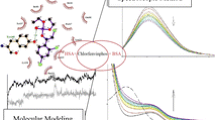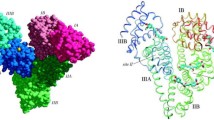Abstract—The kinetics of fluorescence decay of the K-35 probe and the tryptophan amino acid residue were measured after the addition of sodium hypochlorite in human albumin serum (HSA). The K-35 fluorescent probe (excitation 405 nm, fluorescence 530 nm) binds to drug binding site I of albumin. During the experiment the molar concentration of albumin in the fraction varied from 0.3 to 20 μM. Oxidation of the fraction with hypochlorite was recorded by the change in the fluorescence of tryptophan also located in binding site I of albumin (excitation 290 nm, fluorescence 350 nm). It was shown that, at serum albumin concentration of about 30 μM, HSA has antioxidant activity which maintains its ability to bind ligands even after exposure to relatively large amounts of hypochlorite (up to 50 oxidizing molecules per protein molecule). HSA retains its ability to bind ligands because the properties of the K-35 probe during oxidation remained almost unchanged and we observed only insignificant changes in binding characteristics. The added hypochlorite is, predominantly, used to oxidize albumin amino acids, including Trp oxidation as observed in the experiment. For 14 sera of donors, we showed significant differences in the fluorescence of oxidized and native tryptophan.






Similar content being viewed by others
REFERENCES
Colombo, G., Clerici, M., Giustarini, D., Rossi, R., Milzani, A., and Dalle-Donne, I., Antioxid. Redox Signal., 2012, vol. 17, pp. 1515–1527.
Sozarukova, M.M., Proskurnina, E.V., and Vladimirov, Yu.A., Bull. RSMU, 2016, no. 1, p. 56.
Pattison, D.I. and Davies, M.J., Curr. Med. Chem., vol. 13, pp. 3271–3290.
Anraku, M., Yamasaki, K., Maruyama, T., Kragh-Hansen,U., and Otagiri, M., Pharm. Res., 2001, vol. 18, pp. 632–639.
Sudlow, G., Birkett, D.J., and Wade, D.N., Mol. Pharmacol., 1975, vol. 11, pp. 824–832.
Rusconi, F. and Aldo Milzani, A., Journal of Proteomics, 2017, vol. 152, pp. 22–32.
Clare, L. and Hawkins, MichaelJ., Davies, Biochem. J., vol. 340, pp. 539–548.
Robaszkiewicz, A., Bartosz, G., and Soszynki, M., Free Rad. Res., 2008, vol. 42, pp. 30–39.
Chekanov, A.V., Panasenko, O.M., Osipov, A.N., Matveeva, N.S., Kazarinov, K.D., Vladimirov, Iu.A., and Sergienko, V.I., Biophysics, 2005, vol. 50, no. 1, pp. 13–19.
Arnhold, J., Hammerschmidt, S., Wagner, M., Mueller, S., Arnold, K., and Grimm, E., Biomed. Biochim. Acta, 1990, vol. 49, pp. 991–997.
Lissi, E., Biasutti, M.A., Abuin, E., and Leon, L., Journal of Photochemistry and Photobiology B: Biology, 2009, vol. 94, pp. 77–81.
Kawakami, A., Kubota, K., Yamada, N., Tagami, U., Takehana, K., Takehana, K., Sonaka, I., Suzuki, E., and Hirayama, K., FEBS, 2006, vol. 273, pp. 3346–3357
Reza, M., Kooshka, A., Khodarahmi, R., Karimib, S.A., and Nikbakhtc, M.R., Journal of Reports in Pharmaceutical Sciences, 2012, vol. 1, no. 2, pp. 94–106.
Gorinstein, Sh., Goshev, I., Moncheva, S., and Caspi, A., J. Protein Chem., 2000, vol. 19, no. 8, pp. 637–642.
Doumas, B.T., Watsonand, W.A., and Biggs, H.G., Clin. Chim. Acta, 1971, vol. 31, pp. 87–96.
Syrejshchikova, T.I., Gryzunov, Y.A., Smolina, N.V., Uzbekov, M.G., Misionzhnik, E.J., and Maksimova, N.M, Laser Phys., 2010, vol. 20, no. 5, pp. 1074–1078.
Szabo, D.M. and Rayner, J. Am. Chem. Soc., 1980, vol. 102, pp. 2–4.
Dobretsov, G.E., Syrejshchikova, T.I., Smolina, N.V., and Uzbekov, M.G., Nova Publishes, 2015, pp. 129–173.
Smolina, N.V., Syrejshchikova, T.I., Uzbekov, M.G., and Dobretsov, G.E., in Fundamentalnye nauki–medistine. Biofizicheskie meditsinskie tekhnologii (Fundamental Sciences for Medicine. Biophysical Medicine Technologies), Grigoriev, A.I., and Vladimirov, Yu.A., Eds., 2015, Moscow: MAKS Press, vol. 2, pp. 293–327.
Dobretsov, G.E., Syreishchikova, T.I., Gryzunov, Yu.A., Smolina, N.V., and Komar, A.A., Biofizika, 2010, vol. 55, no. 2, pp. 213–219.
Dobretsov, G.E., Gryzunov, Yu.A., Syreishchikova, T.I., Smolina, N.V., Svetlichnyi, V.Yu., and Polyak B.M., Biofizika, 2012, vol. 57, no. 3, pp. 405–409.
Dobretsov, G.E., Syreishchikova, T.I., and Smolina, N.V., Biofizika, 2011, vol. 56, no. 3, pp. 403–406.
Smolina, N.V., Dobretsov, G.E., Syreishchikova, T.I., Gamburg, Yu.D., Kalinina, V.V., and Gryzunov, Yu.A, Efferentnaya i Fiziko-Khimicheskaya Meditsina, 2012, no. 3, pp. 16–21.
Dobretsov, G., Polyak, B., Smolina, N., Babushkina, T., Syrejshchikova, T., Klimova, T., Sverbil, V., Peregudov, A., Gryzunov, Y., and Sarkisov, O., Journal of Photochemistry and Photobiology, A: Chemistry, 2013, vol. 251, pp. 134–140.
Funding
The work was supported by budgetary funding. There is no external funding.
Author information
Authors and Affiliations
Corresponding author
Ethics declarations
Conflict of interest. The authors declare that they have no conflicts of interest.
Ethical approval. All volunteers who donated blood, gave informed consent to participate in the study. The study was conducted in accordance with the Declaration of Helsinki on Ethical Principles for Medical Research with Human Participation and the conclusion of the local ethics committee of the Moscow Research Institute of Psychiatry.
Informed consent. Informed voluntary consent was obtained from each of the participants enrolled in the study.
Rights and permissions
About this article
Cite this article
Syrejshchikova, T.I., Smolina, N.V., Uzbekov, M.G. et al. Study of Modification of Drug Binding Site I of Human Serum Albumin by Sodium Hypochlorite by Time Resolved Fluorescent Spectroscopy. Neurochem. J. 15, 254–259 (2021). https://doi.org/10.1134/S1819712421030119
Received:
Revised:
Accepted:
Published:
Issue Date:
DOI: https://doi.org/10.1134/S1819712421030119




